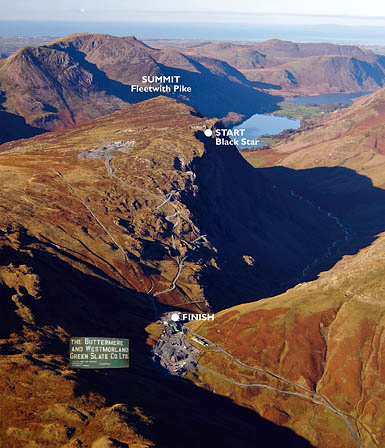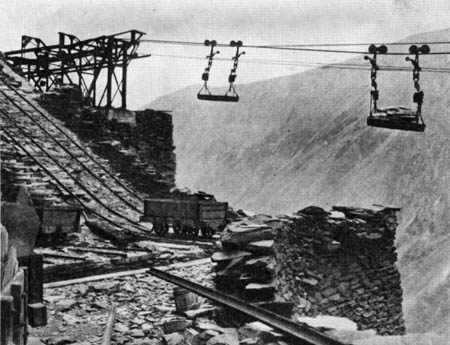
A picture supplied by Honister Slate Mine which, it says, shows the start and finish point of the zip wire. Photo: Brian Sherwen Photography
The operators of a Lakeland mine at the centre of a controversial plan to install a zip wire on the side of a mountain said today they will carry on with the proposals despite the mine’s owner dying in a helicopter crash last month.
A Honister Slate Mine spokesperson said the company intended to press ahead with a revised application for the 1.2km wire slide.
And they announced it would be called the Zip Weir in honour of the mine’s late owner Mark Weir whose helicopter crashed on 8 March just a few hundred metres from the mine, between Borrowdale and Buttermere.
Following the 45-year-old businessman’s death, there was speculation the scheme would be mothballed, but the company said revised plans would be submitted to the Lake District National Park Authority. The original application was withdrawn after attracting opposition from conservationists, including the Friends of the Lake District.
A spokesperson for Mark Weir’s family said: “Since Mark died, many people have told us not to give up on the zip wire because they think it would be a tribute to him and they want to be the first down it.
“He would hate it if we gave up on his dream, which we know has excited so many local people and visitors to the mine. Mark’s passion was for the Cumbrian community to benefit from this, as it has from the mine being reopened, with visitors coming to stay in the area.”
“We know it will not be to everyone’s taste but we would hope they can see that this should be a national park for everyone’s enjoyment.
“Business development and innovation in the right places shouldn’t be mothballed just because it’s the Lake District. This quarry is the right place for a zip wire and the only place for one in the Lakes. We would hope people will see that it will represent everything Mark was – unique, daring, innovative, adventurous, fun, and a brilliant advertisement for the area and enjoying life.”
The spokesperson pointed out the area was already scarred by industry after centuries of slate mining. “Rusting relics of early 19th century mining infrastructure and shattered slate scar the cliff faces of Fleetwith Pike making the actual starting point for the zip wire a no-go areas for walkers,” the spokesperson said.
“It is hoped that environmental groups and national park planners will see the area is an industrial site and capable of hosting the new tourism experience.
“This will involve a 1,200m zip wire running from a concealed cliff-face called Black Star some distance below the summit of Fleetwith Pike all the way back down to the Honister Slate Mine buildings, for people to try.”
The company spokesperson said the new proposals include a detour around certain areas and routing people partially through the mine tunnels inside the mountain so they can reach the start site. “Anyone doing the zip weir would also have to walk to it – a climb of around 1,000ft,” the spokesperson added.
“The starting point of the wire would also be disguised in a small stone-clad column resembling a mountain-top cairn, while the line of the wire is likely to be barely visible against the fell face, and not from popular neighbouring peaks like Haystacks.”
The new plans will be discussed by the Lake District National Park Authority’s development control committee – possibly in May or June.
Before his death, Mr Weir said of the project: “It would help Honister address the ebb and flow of tourism and slate mining by retaining more staff for a longer period over the season, and providing something new and exciting for visitors to the Lakes to try.
“This is vitally important in such a rural corner of Cumbria like Borrowdale where new job opportunities for people across this valley are rare.”
In 1926, a cable-car-type operation called the Lancaster Aerial was built on a cliff-face of Fleetwith Pike
It was used to get heavy slate off the mountain side and down into the Honister factory buildings for processing.

Colin Wells
01 April 2011Any reasonable person would suppose that a giant zip wire running from the top of Blackpool Tower might be a more appropriate location for a development like this - except, of course, ironically, planning permission would probably be unlikely to be forthcoming, what with it being part of the national heritage and all that.
Nice try by the developer's spokesman that because there has been quarrying at the site in the past, it should be fair game for fairground-style attractions. Very convenient that, given that pretty much the whole of the British Isles has had some form of 'development' over the past 5 millennia - the logical extrapolation of that view would be that practically any landscape should be written off as ripe for commercial exploitation.
There's all that unsightly prehistoric quarrying on the Langdale Pikes for example - an eyesore that obviously might be put to good use by business. And as for all those linear piles of quarried stones that litter the landscape - what do they call them - 'Dry stone walls' or something? Yep, let's face it, it's a mess, the whole Lake District is smothered by 'rusting relics' from the past - not worth bothering about at all...
Basically, the spokesman is spinning a ludicrously specious justification. This should be sufficient in itself to throw out the next attempt at further Disneyfication.
alan
01 April 2011april fool may be
andy holt
02 April 2011Colin Wells is obviously Victor Meldrew !
A real anorak NIMBY selfish self centered miserable git !
left to people like him we would still be in the stone age !
David Sullivan
02 April 2011So when we walk in the fells are we supposed to just look at the remains of past mines & quarries whilst sadly pontificating about the past but stopping anyone from finding work in them in the present? Because we love to walk or climb the hills does not mean they should be kept for our sole use.
First and foremost they are someone's workshop, a place where a living has to be earned,wether that be farming and yes even a mine is part of that. Are the people who work in these business supposed to give up their jobs to try and find low paid seasonal work in the tourist industry serving us in our playground?
The plans at Honister do not endanger my enjoyment of the fells or my right to walk where I wish in the area. How do I know that? By actually speaking tp them face to face to discuss their plans.
The mine at Honister not only provides much needed employment in a rural location but attracts visitors to the fells who otherwise would not have come. These people stay in the area, spend money in the area, spreading the benefits to the wider community.
Far from being " Disneyfication" it is entirely consistant with the history of Lakeland. Mining has been going on there for thousands of years & long may it continue!
PhilW
02 April 2011I met Mark a couple of times and must admit that he was a bit unorthodox and had views that not everyone would agree with. But I think his heart was in the right place. This would be a suitable memorial but obviously needs to be done in a sympathetic manner.
Jon
03 April 2011As long as all the punters are suitably gagged I'm sure it will be fine. I really don't like the thought of Blackpool-style screaming above Honister.
Deugar
11 April 2011How sad that Andy Holt should abuse this forum and abuse others. And how ironic that such an uncivilised posting should accuse someone of coming from the stone age. Colin Wells is absolutely right and its clear Andy Holt has no rational argument against him.
WWoo
08 July 2011We knew Mark well and have visited the mine many times. When the via Ferrata opened we thought it was an excellent way to do both a Via Ferata and get a further insight into the old mining activities.
We currently live in the French Alps, where Via Ferratas are very popular. Regarding the zip wire, given that there used to be an aerial way to remove the slate, I really don't see why the proposed plans have caused such a stir.
Would it be possible for a Mountain guide to fix a temporary wire so that people could see it and try it?
I'm not sure exactly what it is that all the oposition are against? Whilst I can appreciate the concerns regarding traffic and parking, I am sure that there are sensible solutions that can be worked through.
There are a number of zip wires here in France and they are popular and fun and have limited visual impact. I suspect that if the objectors actually saw what was planned and tried the wire for themselves they would see that it is not a Blackpool Tower like attraction at all but a mountain experience, befitting a resurrected mining area of rugged beauty, fascinating industrial heritage, charm and public interest.
I strongly disagree with Colin. Indeed I see his comments about fairground attractions and Disneyfication as very foolish....they were on April 1st?!